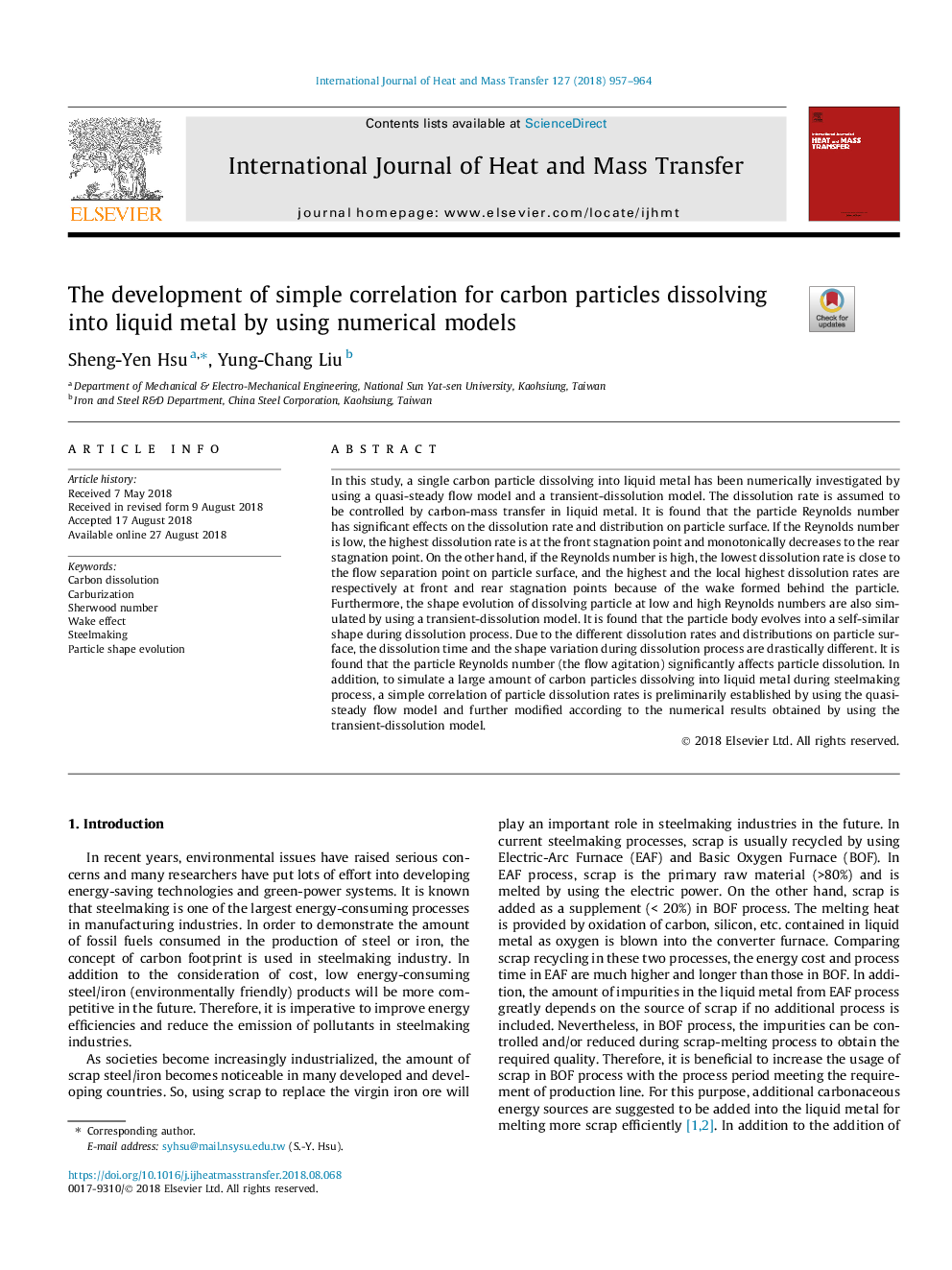| کد مقاله | کد نشریه | سال انتشار | مقاله انگلیسی | نسخه تمام متن |
|---|---|---|---|---|
| 10127395 | 1645051 | 2018 | 8 صفحه PDF | دانلود رایگان |
عنوان انگلیسی مقاله ISI
The development of simple correlation for carbon particles dissolving into liquid metal by using numerical models
ترجمه فارسی عنوان
توسعه همبستگی ساده برای ذرات کربن که به وسیله استفاده از مدل های عددی حل شده به فلز مایع هستند
دانلود مقاله + سفارش ترجمه
دانلود مقاله ISI انگلیسی
رایگان برای ایرانیان
کلمات کلیدی
انحلال کربن، کاربراسیون، شماره شروود، تأثیر واکس، فولادسازی، تکامل شکل ذرات،
ترجمه چکیده
در این مطالعه، یک ذره تک کربن که به فلز مایع حل شده است، با استفاده از یک مدل جریان شبه ثابت و یک مدل انحلال گذار بررسی شده است. فرض بر این است که سرعت انحلال توسط انتقال جرم کربن در فلز مایع کنترل می شود. مشخص شده است که تعداد رینولدز ذرات اثر قابل توجهی بر سرعت و توزیع انحلال در سطح ذرات دارد. اگر تعداد رینولدز پایین باشد، بیشترین میزان انحلال در نقطه رکود جلو قرار دارد و به طور یکنواخت به نقطه رکود عقب کاهش می یابد. از سوی دیگر، اگر تعداد رینولدز بالا باشد، کمترین میزان انحلال نزدیک به نقطه تفکیک جریان در سطح ذرات است و بالاترین و بالاترین میزان انحلال محلی به ترتیب در نقاط رکود جلو و عقب به علت بیدار شدن در پشت ذره علاوه بر این، تکامل شکل ذرات حل شده در اعداد رینولدز کم و زیاد نیز با استفاده از یک مدل انحلال گذرا شبیه سازی شده است. بدست می آید که ذرات ذره در طول فرایند انحلال به یک شکل مشابه خود تبدیل می شوند. با توجه به نرخ های مختلف انحلال و توزیع روی سطح ذرات، زمان انحلال و تغییر شکل در طول پروسه انحلال، کاملا متفاوت هستند. مشخص شده است که تعداد رینولدز ذرات (جریان آستانه) به طور قابل توجهی بر انحلال ذرات تاثیر می گذارد. علاوه بر این، برای شبیه سازی مقدار زیادی از ذرات کربن که در فرآیند تولید فولاد حل شده به فلز مایع، یک همبستگی ساده میزان انحلال ذرات با استفاده از مدل جریان تقریبا ثابت و با توجه به نتایج عددی حاصل از استفاده از گذرا مدل تخریب
موضوعات مرتبط
مهندسی و علوم پایه
مهندسی شیمی
جریان سیال و فرایندهای انتقال
چکیده انگلیسی
In this study, a single carbon particle dissolving into liquid metal has been numerically investigated by using a quasi-steady flow model and a transient-dissolution model. The dissolution rate is assumed to be controlled by carbon-mass transfer in liquid metal. It is found that the particle Reynolds number has significant effects on the dissolution rate and distribution on particle surface. If the Reynolds number is low, the highest dissolution rate is at the front stagnation point and monotonically decreases to the rear stagnation point. On the other hand, if the Reynolds number is high, the lowest dissolution rate is close to the flow separation point on particle surface, and the highest and the local highest dissolution rates are respectively at front and rear stagnation points because of the wake formed behind the particle. Furthermore, the shape evolution of dissolving particle at low and high Reynolds numbers are also simulated by using a transient-dissolution model. It is found that the particle body evolves into a self-similar shape during dissolution process. Due to the different dissolution rates and distributions on particle surface, the dissolution time and the shape variation during dissolution process are drastically different. It is found that the particle Reynolds number (the flow agitation) significantly affects particle dissolution. In addition, to simulate a large amount of carbon particles dissolving into liquid metal during steelmaking process, a simple correlation of particle dissolution rates is preliminarily established by using the quasi-steady flow model and further modified according to the numerical results obtained by using the transient-dissolution model.
ناشر
Database: Elsevier - ScienceDirect (ساینس دایرکت)
Journal: International Journal of Heat and Mass Transfer - Volume 127, Part C, December 2018, Pages 957-964
Journal: International Journal of Heat and Mass Transfer - Volume 127, Part C, December 2018, Pages 957-964
نویسندگان
Sheng-Yen Hsu, Yung-Chang Liu,
